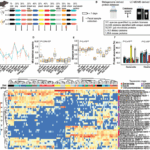2025-04-14 カリフォルニア大学サンフランシスコ校(UCSF)
<関連情報>
- https://www.ucsf.edu/news/2025/04/429791/popular-ct-scans-could-account-5-all-cancer-cases-year
- https://jamanetwork.com/journals/jamainternalmedicine/fullarticle/2832778
現在のコンピュータ断層撮影画像から予測される生涯がんリスク Projected Lifetime Cancer Risks From Current Computed Tomography Imaging
Rebecca Smith-Bindman, MD; Philip W. Chu, MS; Hana Azman Firdaus, MPH; et al
JAMA Internal Medicine Published: April 14, 2025
DOI:10.1001/jamainternmed.2025.0505

Key Points
Question How many future cancers could result from radiation exposure from annual computed tomography (CT) examinations in the United States?
Findings In this risk model, the 93 million CT examinations performed in 62 million patients in 2023 were projected to result in approximately 103 000 future cancers. Although the per-examination cancer risk was higher in children, higher CT utilization among adults accounted for the majority of the projected cancers.
Meaning These findings suggest that if current radiation dosing and utilization practices continue, CT-associated cancers could eventually account for 5% of all new cancer diagnoses annually.
Abstract
Importance Approximately 93 million computed tomography (CT) examinations are performed on 62 million patients annually in the United States, and ionizing radiation from CT is a known carcinogen.
Objective To project the number of future lifetime cancers in the US population associated with CT imaging in 2023.
Design, Setting, and Participants This risk model used a multicenter sample of CT examinations prospectively assembled between January 2018 and December 2020 from the University of California San Francisco International CT Dose Registry. Data analysis was conducted from October 2023 to October 2024.
Main Outcomes and Measures Distributions of CT examinations and associated organ-specific radiation doses were estimated by patient age, sex, and CT category and scaled to the US population based on the number of examinations in 2023, quantified by the IMV national survey. Lifetime radiation-induced cancer incidence and 90% uncertainty limits (UL) were estimated by age, sex, and CT category using National Cancer Institute software based on the National Research Council’s Biological Effects of Ionizing Radiation VII models and projected to the US population using scaled examination counts.
Results An estimated 61 510 000 patients underwent 93 000 000 CT examinations in 2023, including 2 570 000 (4.2%) children, 58 940 000 (95.8%) adults, 32 600 000 (53.0%) female patients, and 28 910 000 (47.0%) male patients. Approximately 103 000 (90% UL, 96 400-109 500) radiation-induced cancers were projected to result from these examinations. Estimated radiation-induced cancer risks were higher in children and adolescents, yet higher CT utilization in adults accounted for most (93 000; 90% UL, 86 900-99 600 [91%]) radiation-induced cancers. The most common cancers were lung cancer (22 400 cases; 90% UL, 20 200-25 000 cases), colon cancer (8700 cases; 90% UL, 7800-9700 cases), leukemia (7900 cases; 90% UL, 6700-9500 cases), and bladder cancer (7100 cases, 90% UL, 6000-8500 cases) overall, while in female patients, breast was second most common (5700 cases; 90% UL, 5000-6500 cases). The largest number of cancers was projected to result from abdomen and pelvis CT in adults, reflecting 37 500 of 103 000 cancers (37%) and 30 million of 93 million CT examinations (32%), followed by chest CT (21 500 cancers [21%]; 20 million examinations [21%]). Estimates remained large over a variety of sensitivity analyses, which resulted in a range of 80 000 to 127 000 projected cancers across analyses.
Conclusions and Relevance This study found that at current utilization and radiation dose levels, CT examinations in 2023 were projected to result in approximately 103 000 future cancers over the course of the lifetime of exposed patients. If current practices persist, CT-associated cancer could eventually account for 5% of all new cancer diagnoses annually.


